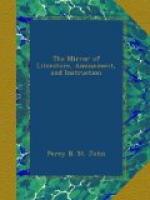And many are the pilgrim’s feet
which tread
Its rocky steps, which thither
yearly go;
Yet, less by love of Nature’s wonders
led,
Than by the memory of a mighty
woe,
Which smote, like blasting
thunder, long ago,
The peopled hills. There stands a
sacred tomb,
Where tears have rained, nor
yet shall cease to flow;
Recording days of death’s sublimest
gloom;
Mompesson’s power and pain,—his
beauteous Catherine’s doom.
[2] Dr. Mead, in his Narrative
of the Great Plague in London,
particularly mentions its
introduction into Eyam, through the
medium of a box of clothes,
sent to a tailor who resided there.
[3] Table Book, 1827, p. 481.
The cross at Eyam stands near the entrance into the chancel of the church. According to village tradition, this rare relic was found on some of the neighbouring hills. It is curiously ornamented with symbolic devices in bold relief. “It has suffered dilapidation from the culpable neglect of those who should have felt an interest in its preservation. About two feet of the top of the shaft is wanting, as may be seen by reference to the engraved sketch, (See the Cut,) which was taken in the year 1815.” The sexton of the church, who was then an old man, told Mr. Rhodes in 1818, that he well recollected the missing part being thrown carelessly about the churchyard, as if of no value, until it was broken up by some of the inhabitants, and knocked to pieces for domestic purposes. The preservation of the Cross, to the extent we have shown, is referable to the philanthropic Howard, who, in a visit to Eyam, about the year 1788, or 44 years since, particularly noticed the finest part of the relic lying in a corner of the churchyard, and nearly overgrown with docks and thistles. “The value this hitherto unregarded relic had in the estimation of Howard,” says Mr. Rhodes, “made it dearer to the people of Eyam: they brought the top part of the cross from its hiding-place, and set it on the still dilapidated shaft, where it has ever since remained.” Other crosses, similar in appearance and workmanship, have been found on the hills of Derbyshire, particularly one in the village of Bakewell, which we have already figured in The Mirror.[4] It evidently originated with the same people as that at Eyam, though it is much more mutilated. These crosses have been generally regarded as Saxon or Danish, though the probability is in favour of the Saxon origin, from the high veneration of the Saxons for the sacred symbol of the cross. Thus, stone crosses were not only parts of the decorations of every church and altar, but set up as land-marks on the high roads as aids to devotion, and in market-places as incentives to integrity and fair-dealing.
[4] Vol. xi. p. 40.
Near the cross at Eyam, and in the distance of the Cut, is the tomb of Mrs. Mompesson, on one end of which is an hour-glass with two expanded wings; and underneath on an oblong tablet is inscribed CAVETE; (beware,) and nearer the base, the words Nescitis Horam (ye know not the hour). On the other end of the tomb is a death’s head resting on a plain, projecting tablet; and below the words Mihi lucrum (mine is the gain).




